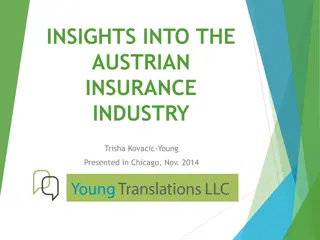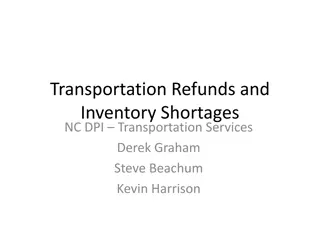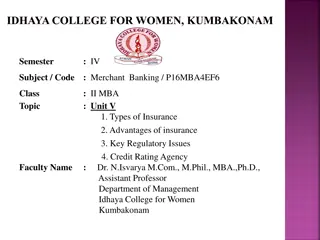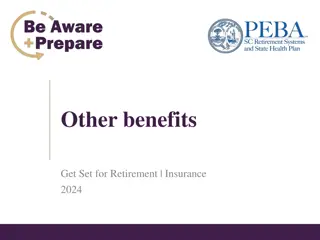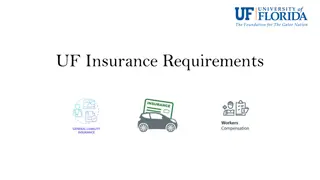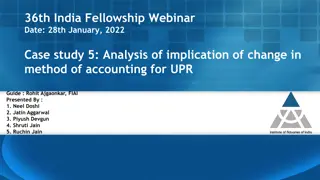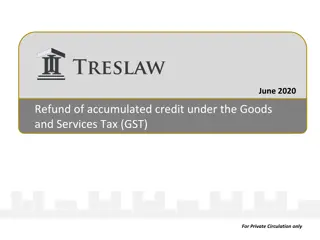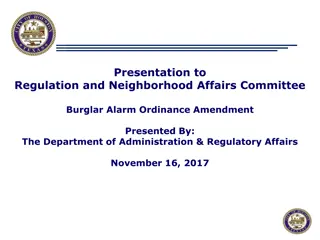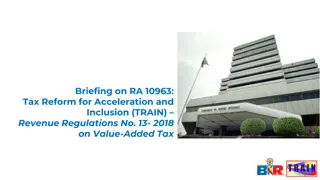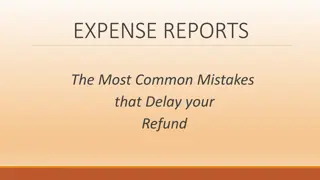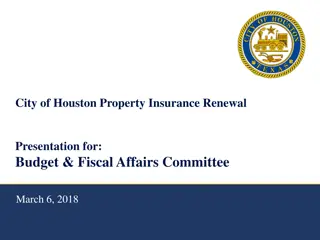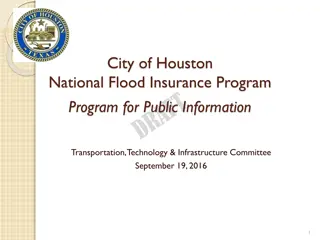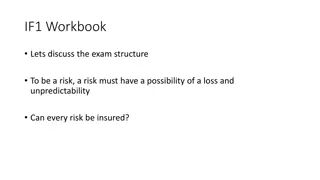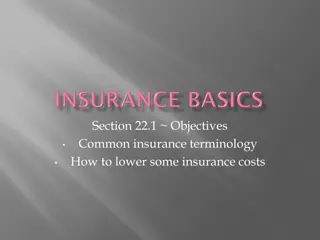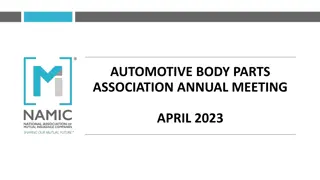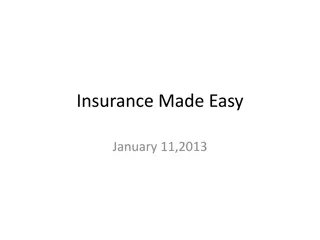Understanding Bonus Systems and Premium Refunds in Insurance
Bonus systems in insurance reward policyholders with fewer claims in the past by offering premium refunds. Various models are used to calculate premium refunds, factoring in individual claim history or overall portfolio performance. This article explores common solutions such as premium refunds based on own claims indicators and the impact on an insurer's risk.
Download Presentation

Please find below an Image/Link to download the presentation.
The content on the website is provided AS IS for your information and personal use only. It may not be sold, licensed, or shared on other websites without obtaining consent from the author. Download presentation by click this link. If you encounter any issues during the download, it is possible that the publisher has removed the file from their server.
E N D
Presentation Transcript
Bonus systems, premium refund Introduction The basic principle of bonus systems is if somebody has less claims in the past then there is probable that in the future he/she has less claims also. Insurers have varied solutions to manage this theme we will consider the most common types of solutions. Insurance mathematics V. lecture
Premium refund in case of less claims I. The insured gets back a part of premium after one insurance period (typically one policy year) if he/she has less claims and/or his/her total claim is low. The premium refund can depend on the result of total portfolio, but in the most common cases the premium refund depends on just own claim indicators. This solution are used for varied products, most typical for CASCO. The model of premium refund can be built in the most cases as follows: Let = ?1+ ?2+ + ? the total risk of insurer without premium refund and d the annual premium. Then the total risk of insurer with premium refund will be the next formula: Insurance mathematics V. lecture
Premium refund in case of less claims II. ? ? = + ? ( ?? = ? + ?? (?? 1< ??)) ?=0 ?=0 where K,J are given positive integer, 0 ?,??;(0 ? ?,0 ? ?) and 0 = ?0< ?1< < ?? are given constants. If the premium refund is available in case of without claim or low total claim then the formula will be easier: or = + ? ? ? = + ? ? = 0 In each case the total risk of insurer will increase with one non-negative variate it means that the premium refund will extend the basic annual premium. Insurance mathematics V. lecture
Premium refund in case of less claims III. Statement: Let the insurer uses expected value principle with parameter in the premium calculation. If insured has k claims (0 ? ?) in insurance period then insurer will pay back ??part of the annual premium. If the total claim is more than ?? 1and less than ??then the insurer will pay back ?? part of annual premium (1 ? ?). Then the basic premium will be as follows: ???(?) (1 + ) 0 ?? ??+ ?=1 ? = ? ? 1 (1 + ) ( ?=0 ?? (? ?? ? ?? 1) where ??signs the probability of k claims, F(x) signs the distribution function of risk without premium refund. Insurance mathematics V. lecture
Premium refund in case of less claims IV. Remarks: - with adequate giving there is possible to adjust adequate cost and security level; - from formula it can be seen that the premium is increasing, because without premium would be (1 + ) premium refund the ???(?) 0 Insurance mathematics V. lecture
Premium refund in case of less claims V. Proof: ? ? = 1 + ? = (1 + ) (? + ? ( ?? ? = ? + ?=0 ? + ?? ?(?? 1 < ??)) ?=0 It follows ???(?) (1 + ) 0 ?? ??+ ?=1 ? = ? ? 1 (1 + ) ( ?=0 ?? (? ?? ? ?? 1) Insurance mathematics V. lecture
Premium refund in case of less claims VI. Statement: Let the insurer uses variance principle with parameter in the premium calculation. We suppose that the part of premium will be the cost loading and the insurer will get back part of premium in case of claim-less. Then for the d annual premium we will get the next quadratic equation: ??2? 1 ? ?2+ ?? 2???? 1 + ? ? + ? + ??2= 0 where ? = ? = 0 ,? = ? ,?2= ?2( ) Insurance mathematics V. lecture
Premium refund in case of less claims VII. Proof: ? = ? + ??? = 0 = ? + ??? ?2 = ?2 + ?2?2?2 = 0 + 2?? ???( , = 0 ) = ?2+ ?2?2? 1 ? + = ?2+ ?2?2? 1 ? 2???? +2?? ? = 0 E ? = 0 Because of net premium was calculated with variance principle: 0 = ? + ??2 + ? 1 ? 1 ? ? = ? + ??2 It means that ? + ??? + ??2+ ??2?2? 1 ? 2????? + ? 1 ? = 0 Insurance mathematics V. lecture
Claim-free allowance (No Claim Bonus) I. Insurer gives allowance in advance for next policy year based on earlier claim-free claim experience. There are k different sections, 1,2, k. Usually the new insured goes to the 1. section and after every claim-free policy year he/she goes 1. step forward (till k-th section). Every claim causes one step backward (till 1. section). Insurance mathematics V. lecture
Claim-free allowance (No Claim Bonus) II. Advantages: - insured is interested to be claim-free; - low claims will not be reported; - premiums are more adequate (related to actual risk) - it will be more homogenous risk groups. Disadvantages: - in case of liability insurance the insured can try to avoid his/her liability; - more complicated premium calculation, reserving and administration. Insurance mathematics V. lecture
Claim-free allowance III. Example: There are three section. The new insured goes to 1. section and after every claim-free policy year he/she goes 1. step forward (till 3-th section). Every claim causes one step backward (till 1. section). We suppose that the distribution of claim number is Poisson distribution with 0,1 parameter. We will sign ?0the probability of 0 claim, ?1the probability of 1 claim. Then the transition-probability matrix will be as follows: 1 ? 0,1 1 ? 0,1 ? 0,1 0 0,1? 0,1 1 ?0 1 ?0 1 ?0 ?1 ?0 0 ?1 0 ?0 ?0 0 ? 0,1 ? 0,1 ? = = 1 ? 0,1 0,1? 0,1 Insurance mathematics V. lecture
Bonus-malus systems I. The difference between claim-free allowance and bonus-malus systems is that there are malus sections in bonus-malus systems also. It causes more prudence for insured. The model will be the next: let Z(n) is the bonus section in the n-th year of one policy, the sections are 1,2, ,K (1. section is the worst, K. section is the best). ?;? = 0,1,2, We can define ??? matrixes, ??= ??,? Let ?= 1,?? ???? ? ? ? ? ???.?? ???? ?? ? ?????? ???.???? ?? ? ? ???. 0 ?? ?????? ??,? For consideration there is necessary to take into account the ? ? + ? = ? ? ? = ? ,? 0;? 1;1 ?,? ? probabilities. ? Insurance mathematics V. lecture
Bonus-malus systems II. Usually we assume that Z(n) is Markov chain, i.e. ? ? ? = ? ? 0 ,? 1 , ,? ? 1 = ? ? ? = ? ? ? 1 In this case there is enough to consider the next probabilities ? ? ? + 1 = ? ? ? = ? = ???,? ,? 0;1 ?,? ? If ???,? does not depend on n then the calculation will be much simpler. Insurance mathematics V. lecture
Bonus-malus systems III. The inadequacy of this model is that in this model there is not considered the enter and exit of insured. In the consideration the steady-state will be calculated with the theory of Markov chain and the speed of convergence will be important usually. There is necessary that the measure of bonus percentages or the basic premium will not be fixated. In this case it is achievable that the total premium will be adequate to risk. Usually accepted assumption is that the distribution of number of claim of one insured is Poisson, the distribution of total portfolio is compound Poisson distribution, i.e. ?= ?? ?! ? ? ?,? = ?? ??,? ??,? ?=0 ?=0 Insurance mathematics V. lecture
Bonus-malus systems IV. After starting the BM system the total measure of bonuses are increasing, later the sum of bonuses will be stabilized. It means that the Markov chain converges to steady-state. The speed of convergence depends on the concrete system. In the next consideration we assume that the Markov chain is homogeneous, irreducible and aperiodic. Memo: 1. Markov chain is homogeneous if ? ? ? = ? ? ? 1 = ? = ? 2. Markov chain is irreducible if ?,? 1,2, ,? ? ?:? 3. Markov chain is aperiodic if ?????????? ?:? ? ? = ? ? 0 = ? > 0 = 1 ? 1 = ? ? 0 = ? ? ? = ? ? 0 = ? > 0 Insurance mathematics V. lecture
Bonus-malus systems V. There is a known theorem if a Markov chain is irreducible, aperiodic and the state space is finite then the Markov chain is convergent and the stationer distribution is clearly defined. Let ??:1 ? ? the stationer distribution. It means that: ? ? 0 = ? = ?? ? ? ? = ? = ??;1 ? ? Then: ? ? ?(?,?) ?? and ?=1 ??= ?=1 ??= 1 If we are using vectors, we get: ? = ?? ? ? where ? = (?1,?2, ,??)?; ? = (? ?,? )?,?=1 Insurance mathematics V. lecture
Bonus-malus systems VI. If the premium of i-th section is ?? then ? ?????= ?? ?? ?=1 Furthermore: ? ? ? ? = ? = ??; 1 ? ? lim ? lim ? ???(?)= lim ? ?? ?(? ? = ?) ?=1 Insurance mathematics V. lecture
Bonus-malus systems VII. Example (Hungarian bonus-malus system in MTPL): The new insured goes to A0 section and after every claim-free policy year he/she goes 1. step forward (till B10 section). Every claim causes two steps backward (till M4 section). If one insured causes 4 or more claims in one year then he/she goes to M4. If being claim-free and causing claim have both positive probability then the Markov chain will be irreducible and aperiodic. (B10 has 1 period, it follows that the Markov chain is aperiodic. From any section can getting to any other section with positive probability, it follows the Markov chain is irreducible.) If the number of claim is Poisson distribution then the transition probability matrix will be as follows: Insurance mathematics V. lecture
Bonus-malus systems VIII. Example (continued): 1 ? ? 1 ? ? 1 ? ? 1 ? + 1 ? ? ? ? 0 0 0 ? ? 0 . . . 0 0 ? ? 0 0 0 0 0 0 0 ? ? 0 ? ? 0 3 3!+ 2 2!+ ? + 1 ? ? 0 0 .. ? ? 0 ? ? 1 The most common used bonus-malus factors are as follows: M4 M3 M2 M1 A0 B1 B2 B3 B4 B5 B6 B7 B8 B9 B10 2 1,6 1,35 1,15 1 0,95 0,9 0,85 0,8 0,75 0,7 0,65 0,6 0,55 0,5 Insurance mathematics V. lecture
Bonus-malus systems IX. Example (continued): In the case if we would like to calculate stationer premium and distribution then we have to add claim frequency. For example if claim frequency is 10% then the stationer premium will be 0,5223. It means that the average premium will converge the 52,23% of A0 premium with these assumptions. The stationer distribution will be as follows: ?? ?? ?? ?? ?? ?? ?? 9,4 10 6 1,1 10 4 2,3 10 4 5,6 10 4 1,4 10 5 2,6 10 5 4,9 10 5 ?? ?? ??? ??? ??? ??? ??? ??? 0,779 0,0163 0,0222 0,0905 0,0819 1,1 10 3 3 10 3 5,1 10 3 Insurance mathematics V. lecture
Comparison of bonus-malus systems I. It can be useful if we can compare different bonus-malus systems. We can define some indicators with which we can do easier this comparison. Definition: The relative stationery average level of bonus-malus systems can be defined with the next formula: ????=????? ?? ?1 ?? where ?1is the greatest, ??is the lowest, ?????is the stationer premium. Obviously, 0 ???? 1. If ???? 1 then there are few allowance, if ???? 0 then there are a lot of allowance. Related to Hungarian bonus- malus system ????= 1,52% (if we assume 10% claim frequency). Insurance mathematics V. lecture
Comparison of bonus-malus systems II. Definition: systems can be defined with the next formula: ????=???? ????? The beginning surplus level of bonus-malus ????? where ????is the premium of beginning insured, ????? is the stationer premium. This indicator shows how much is the penalty of beginner insured. Obviously, 0 ???? 1. Related to Hungarian bonus- malus system (if we assume 10% claim ????= 91,3% frequency). Insurance mathematics V. lecture
Comparison of bonus-malus systems III. Definition: The coefficient of variation of premium of bonus- malus systems can be defined with the next formula: ?(?? ?+1 ?? ?)2 ????? ? = This indicator shows how much sensitive is the system regarding actual claim experience. s can be calculated from stationer distribution: 2? ? =?) ?(?? ?+1 ?? ?)2 ? ?=1 ???( ?? ?+1 ?? = ? = = ? ?=1 ????? ???? Insurance mathematics V. lecture
Comparison of bonus-malus systems IV. ? ? ? ? ?(?,?) (?? ??)2 ?? ?(?,?) (?? ??)2 ?=1 ?? ?=1 ?=1 ?=1 = = ? ? ?=1 ?=1 ???? ???? Related to Hungarian bonus-malus system ? = 0,0769 (if we assume 10% claim frequency). Definition: The efficiency of bonus-malus systems can be defined with the next formula: ??????( ) ? ( ) = ?????( ) If the premium would increase with such measure then the claim frequency, the efficiency would be 1. In practice there are always lower than 1. Insurance mathematics V. lecture
Comparison of bonus-malus systems V. The efficiency can be calculated as follows: ? ???? = ?? ?( ) ?????( ) = ?=1 ??( ) ??????( ) ? = ?? ? ??( ) ? can be calculated from the next formula: ??( ) = ?( )???( ) +?? ?? ? ?( ) ? ? Related to Hungarian bonus-malus system ( )=0,064 (if we assume 10% claim frequency). Insurance mathematics V. lecture
Bonus-malus systems Remarks We did not consider some other factors in this chapter. Just some of them: - effect of entering, exiting; - optimum of self-part; - calculation distribution of claim number and claim amount in different bonus sections; - consideration of Markov attribution and homogeneity. Insurance mathematics V. lecture


